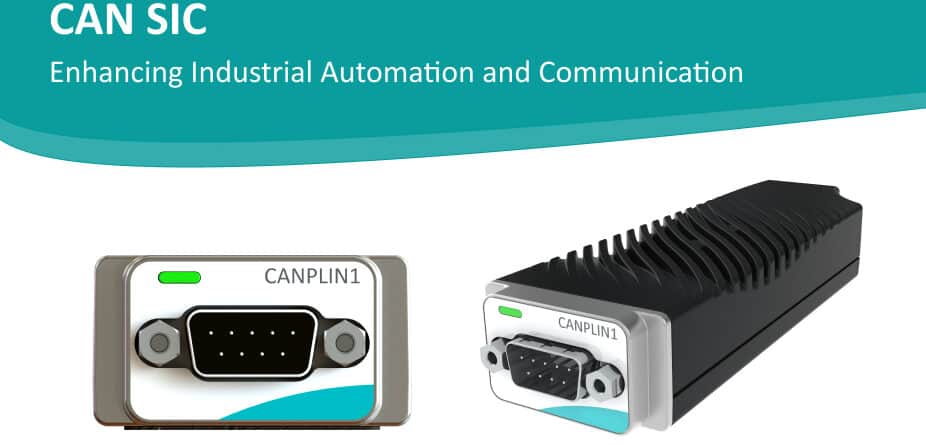CAN SIC: Enhancing Industrial Automation and Communication
Tech Admin2025-06-03T15:07:20+02:00In the realm of industrial automation and automotive systems, reliable and efficient communication protocols are paramount. The Controller Area Network (CAN) protocol has long been a cornerstone of such communication. Recently, advancements have introduced the concept of CAN with Signal Improvement Capability (SIC), a significant evolution in the CAN protocol aimed at enhancing communication robustness, reliability, and performance in increasingly complex and interconnected systems.
Flexmedia XM CANPLIN1 module now supports CAN SIC protocol, in addition to all released CAN flavors, from single-wire to CAN FD/SIC, CAN Fault-tolerant LS and HS (High-Speed and Low Speed) and LIN interface.
Understanding CAN and Its Limitations
The CAN protocol, originally developed by Bosch in the mid-1980s, has been widely adopted in automotive and industrial applications due to its robustness, real-time capabilities, and fault tolerance. It allows microcontrollers and devices to communicate with each other without the need for a host computer. However, as systems have become more interconnected and complex, the original CAN protocol’s limitations, particularly in terms of data rates and signal integrity at higher speeds, have become more apparent.
Introduction to CAN SIC
CAN SIC (Signal Improvement Capability) is an enhancement of Classical CAN and CAN FD, addressing issues with signal reflections and noise in high-speed communication. Traditional CAN transceivers struggle with reflections on the bus at higher bit rates, especially with long bus lengths or complex topologies. SIC transceivers mitigate these challenges by improving signal integrity. Some key features of CAN SIC include:
- Signal Reflection Mitigation: SIC transceivers are designed to minimize the impact of signal reflections at high data rates, ensuring cleaner and more reliable communication.
- Enhanced Electromagnetic Compatibility (EMC): SIC improves the electromagnetic compatibility of the CAN network, reducing radiated emissions, which is crucial for safety-critical systems like automotive and industrial applications.
- Improved Noise Immunity: The signal integrity improvements help to reduce noise susceptibility, which is essential for harsh environments where electromagnetic interference (EMI) can be high.
- Backward Compatibility: CAN SIC transceivers are backward compatible with Classical CAN and CAN FD, meaning they can coexist with traditional CAN transceivers in the same network without causing disruptions.
Enhancements of CAN SIC
- Higher Data Rates: CAN SIC allows the use of CAN FD at its full speed of 8 Mbps while maintaining a higher signal quality, allowing more data to be transmitted in less time.
- Improved Bus Lengths and Network Topologies: With better signal integrity, longer bus lengths and more complex network topologies can be supported, increasing the flexibility of CAN systems.
- Reduced Latency: The enhanced signal integrity and reduction of errors in high-speed communication result in lower latency for real-time systems.
- Hybrid Communication: CAN SIC systems can integrate both Classical CAN and CAN FD devices, allowing for more flexible and scalable network architectures.
Applications of CAN SIC
The applications of CAN SIC span a wide range of industries, each benefiting from the enhanced performance and reliability it offers:
- Automotive Industry: In modern vehicles, especially with the rise of autonomous systems, data traffic has increased significantly. CAN SIC provides the higher bandwidth and reliability needed for sensor fusion, real-time decision-making, and advanced driver-assistance systems (ADAS).
- Industrial Automation: In industries where real-time data exchange is critical, such as robotics and manufacturing systems, CAN SIC ensures reliable communication even in noisy environments.
- Aerospace and Defense: CAN SIC’s enhanced noise immunity and signal integrity make it ideal for use in mission-critical aerospace and defense applications, where data corruption can have severe consequences.
The Future of CAN SIC
The introduction of CAN SIC represents a significant step forward in the evolution of communication protocols for industrial and automotive applications. As technology continues to advance, the need for secure, reliable, and high-performance communication systems will only grow. CAN SIC is poised to play a crucial role in meeting these demands, providing a robust framework for the next generation of interconnected systems.
Conclusion
CAN SIC is a transformative enhancement to the traditional CAN protocol, addressing the critical needs for reliability, data integrity, and higher data rates in modern industrial and automotive systems. By integrating signal integrity features and ensuring compatibility with existing networks, CAN SIC offers a seamless transition to a more reliable and efficient future. As industries continue to evolve, embracing CAN SIC will be key to ensuring the reliability and higher speed of their communication systems, paving the way for innovations and advancements in automation and connectivity.
If you are interested in this product, visit the catalog here: https://flexmediaxm.com/product/canplin1-programmable-can-lin-interfaces/

